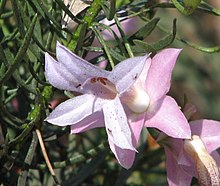Eremophila abietina, also known as spotted poverty bush,[2] is a plant in the figwort family, Scrophulariaceae and is endemic to a few arid areas of Western Australia. It is a stiff, upright, compact and very sticky shrub with distinctive, dark bluish-green leaves and pale coloured flowers spotted purple.
| Spotted poverty bush | |
|---|---|

| |
| Eremophila abietina in Burnley Gardens | |
| Scientific classification | |
| Kingdom: | Plantae |
| Clade: | Tracheophytes |
| Clade: | Angiosperms |
| Clade: | Eudicots |
| Clade: | Asterids |
| Order: | Lamiales |
| Family: | Scrophulariaceae |
| Genus: | Eremophila |
| Species: | E. abietina
|
| Binomial name | |
| Eremophila abietina | |
Description
editEremophila abietina is a stiff, woody, compact and very sticky shrub which usually grows to a height of 0.5–2.5 m (2–8 ft) and often a similar width. Its leaves are densely clustered, sticky due to the presence of resin, linear in shape, 10–45 mm (0.4–2 in) long, 0.7–4.5 mm (0.03–0.2 in) wide and hairy, although the hairs are often obscured by resin.[3][2][4]
The flowers are borne singly in leaf axils on a flattened stalk 15–25 mm (0.6–1 in) long. The sepals overlap and are cream to reddish in colour, 13–15 mm (0.5–0.6 in) long, growing to 18–23 mm (0.7–0.9 in) long after flowering and remain on the shrub long after flowering. The tube formed by the petals is 25–35 mm (0.98–1.4 in) long and is bluish green to pale purple with the lobes spotted purple. Flowering occurs between June and October and is followed by fruit which are dry, oval or cone-shaped and have a distinct prolonged tip.[3][2][4][5]
Taxonomy and naming
editThe species was first formally described by Fritz Kraenzlin in 1925. The description was published in Bulletin of Miscellaneous Information.[6][7] The type specimen was collected from "Laverton; North Coolgardie" by Frederick Arthur Rodway.[6][8] The specific epithet (abietina) reflects the similarity of the foliage of this species with that of conifers in the genus Abies.[3] In 2007 Robert Chinnock described two subspecies and the names have been accepted by the Australian Plant Census:[3]
Distribution and habitat
editSpotted poverty bush occurs on gibber plains, calcareous flats and jasper outcrops in an area of the Great Victoria Desert near Laverton.[5][7][11]
Ecology
editSome native bee species collect wax from E. abietina flower buds and other parts in order to make propolis, causing damage to the plant and sometimes leading to a stunting of its growth.[4][12]
Use in horticulture
editSpotted poverty bush is sometimes a slow growing plant in the garden, but compensates by being long-lived. It grows best in well-drained soil in a sunny situation but tolerates partial shade. It will only tolerate light frosts but responds well to pruning when frost-damaged. The metallic colouring of the flowers and persistent sepals make this an attractive species. Propagation from seed and from cuttings is difficult and most garden plants are produced by grafting onto Myoporum.[4]
Conservation status
editEremophila abietina is classified as "not threatened" by the Government of Western Australia Department of Parks and Wildlife.[5]
References
edit- ^ "Eremophila abietina". Australian Plant Census. Retrieved 5 July 2019.
- ^ a b c d e Brown, Andrew; Buirchell, Bevan (2011). A field guide to the eremophilas of Western Australia (1st ed.). Hamilton Hill, W.A.: Simon Nevill Publications. pp. 30–31. ISBN 9780980348156.
- ^ a b c d Chinnock, Robert J. (2007). Eremophila and allied genera : a monograph of the plant family Myoporaceae (1st ed.). Dural, NSW: Rosenberg. pp. 622–625. ISBN 9781877058165.
- ^ a b c d e f Boschen, Norma; Goods, Maree; Wait, Russell (2008). Australia's eremophilas : changing gardens for a changing climate. Melbourne: Bloomings Books. pp. 62–63. ISBN 9781876473655.
- ^ a b c "Eremophila abietina". FloraBase. Western Australian Government Department of Biodiversity, Conservation and Attractions.
- ^ a b "Eremophila abietina". APNI. Retrieved 17 November 2015.
- ^ a b Moore P. (2005). Plants of Inland Australia. Reed New Holland. ISBN 187633486X.
- ^ "Rodway, Frederick A. (1880 - 1956)". Australian National Botanic Garden. Retrieved 5 June 2018.
- ^ "Eremophila abietina subsp. abietina". Australian Plant Census. Retrieved 5 July 2019.
- ^ "Eremophila abietina subsp. ciliata". Australian Plant Census. Retrieved 5 July 2019.
- ^ Paczkowska, Grazyna; Chapman, Alex R. (2000). The Western Australian flora : a descriptive catalogue. Perth: Wildflower Society of Western Australia. p. 333. ISBN 0646402439.
- ^ Jennings, Colin. "Eremophila and pollinators". Australian Native Plants Society (Australia). Retrieved 2 April 2016.